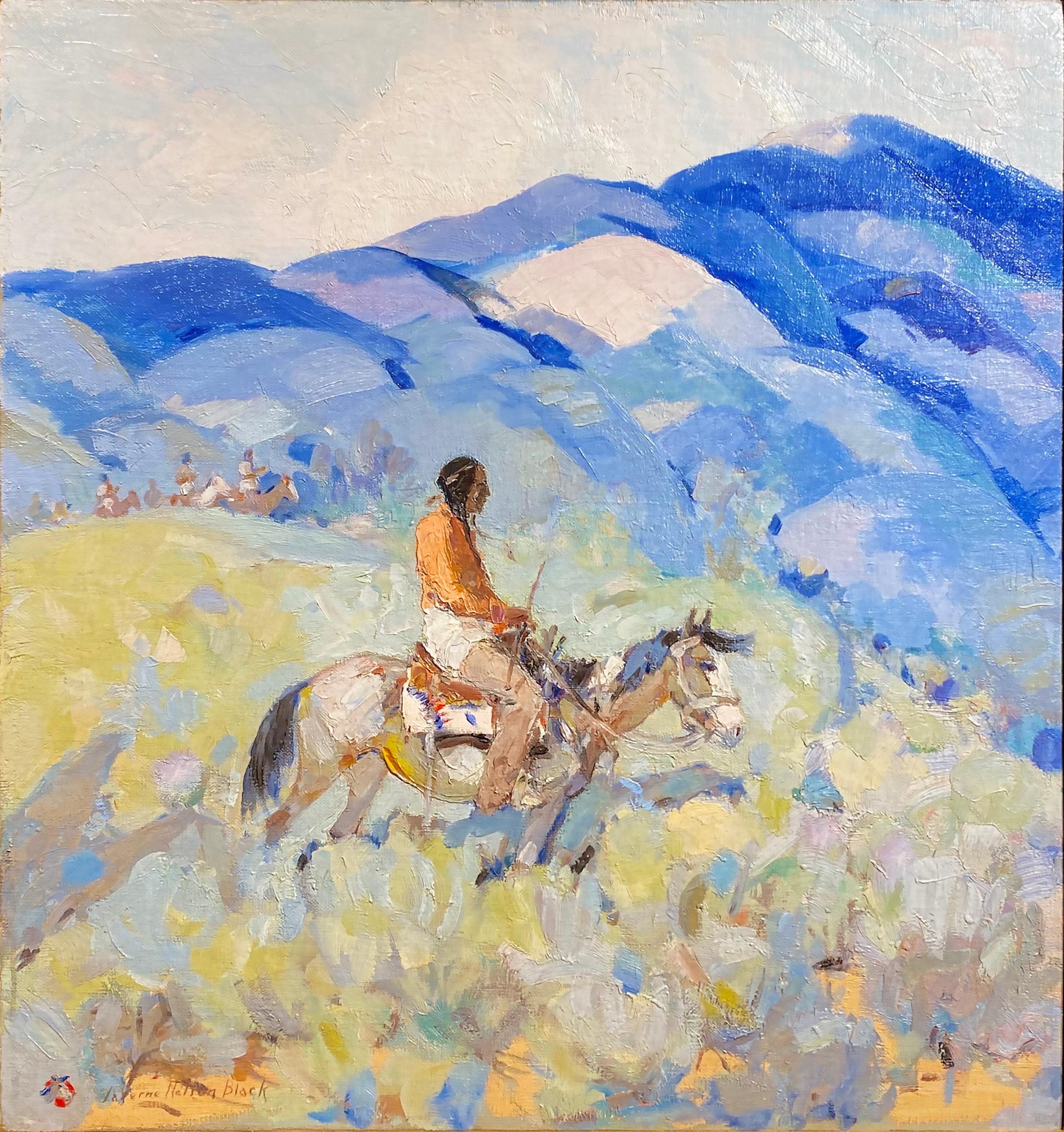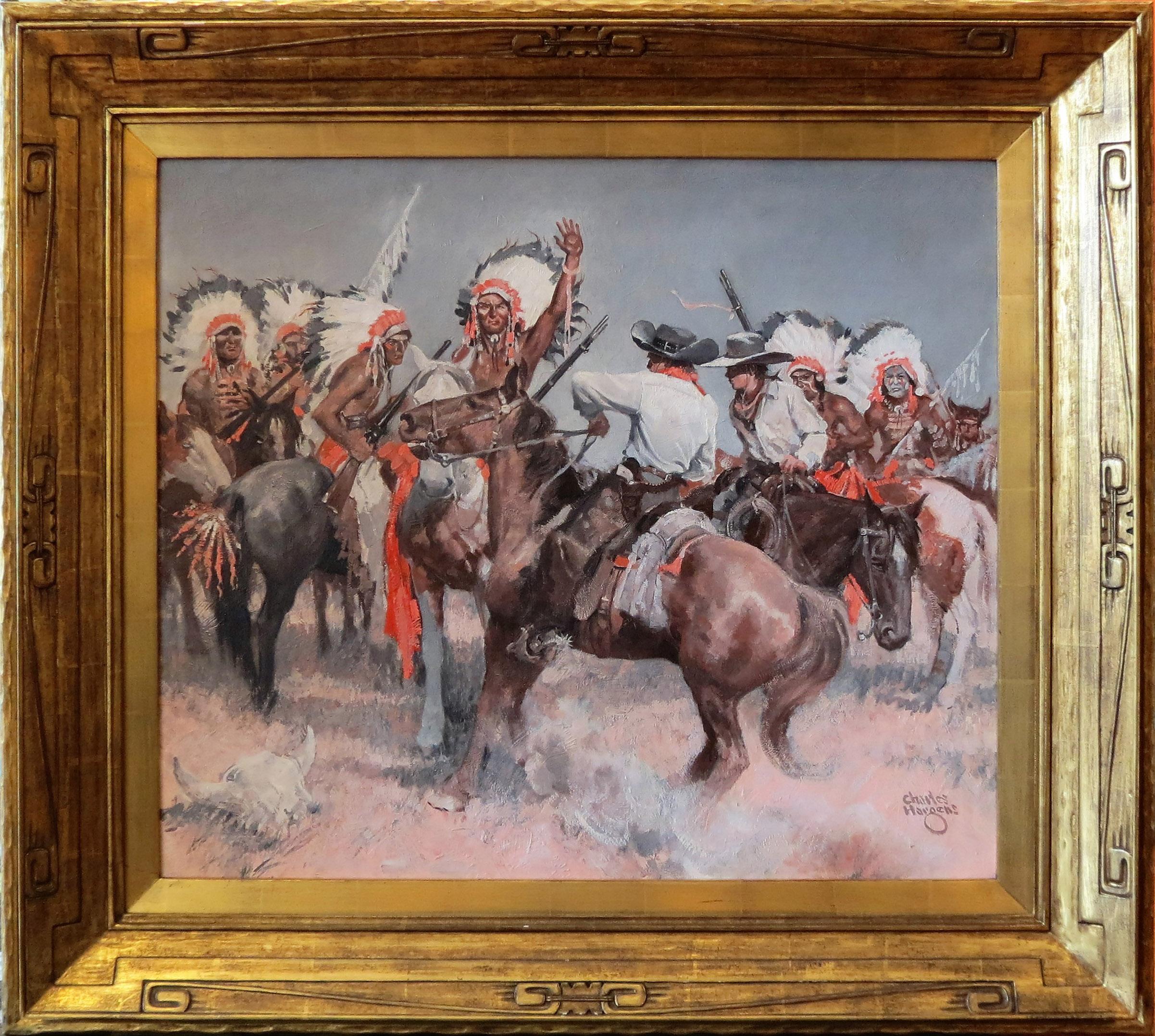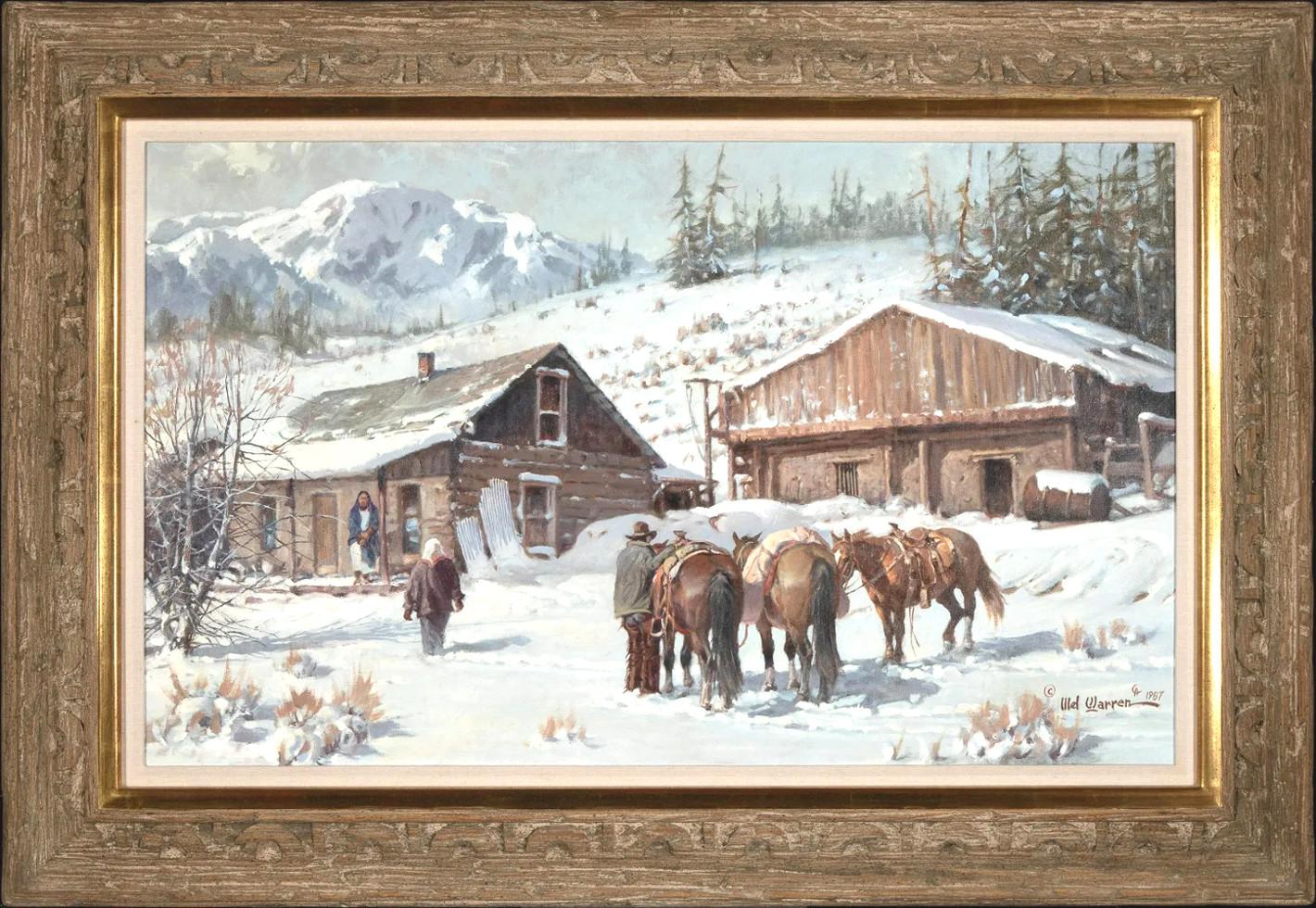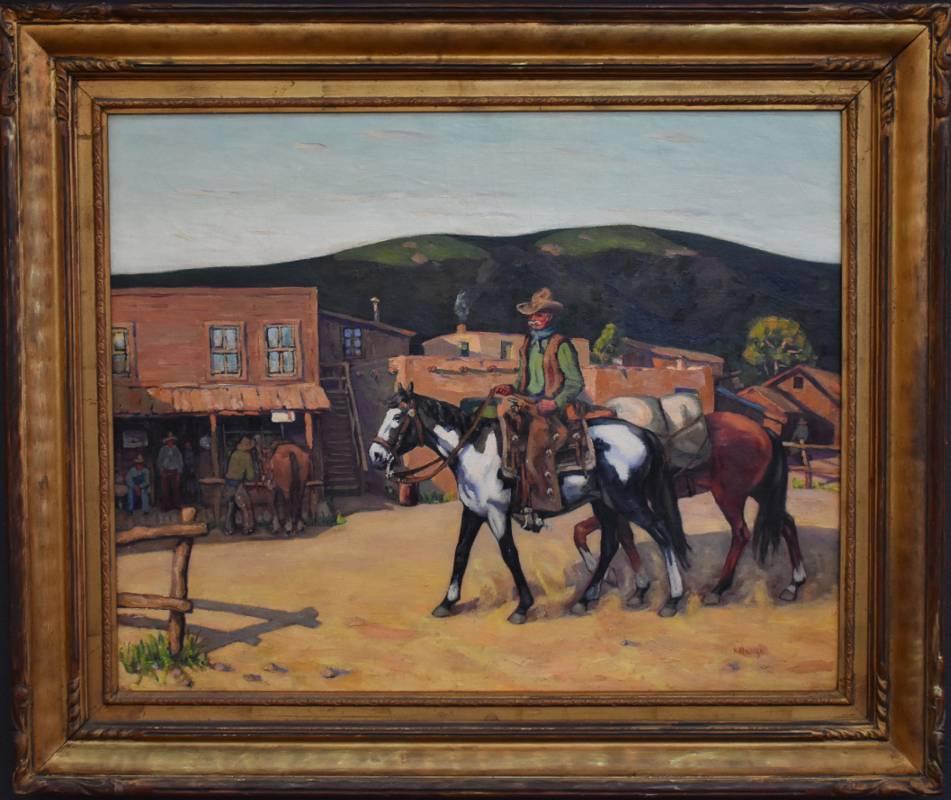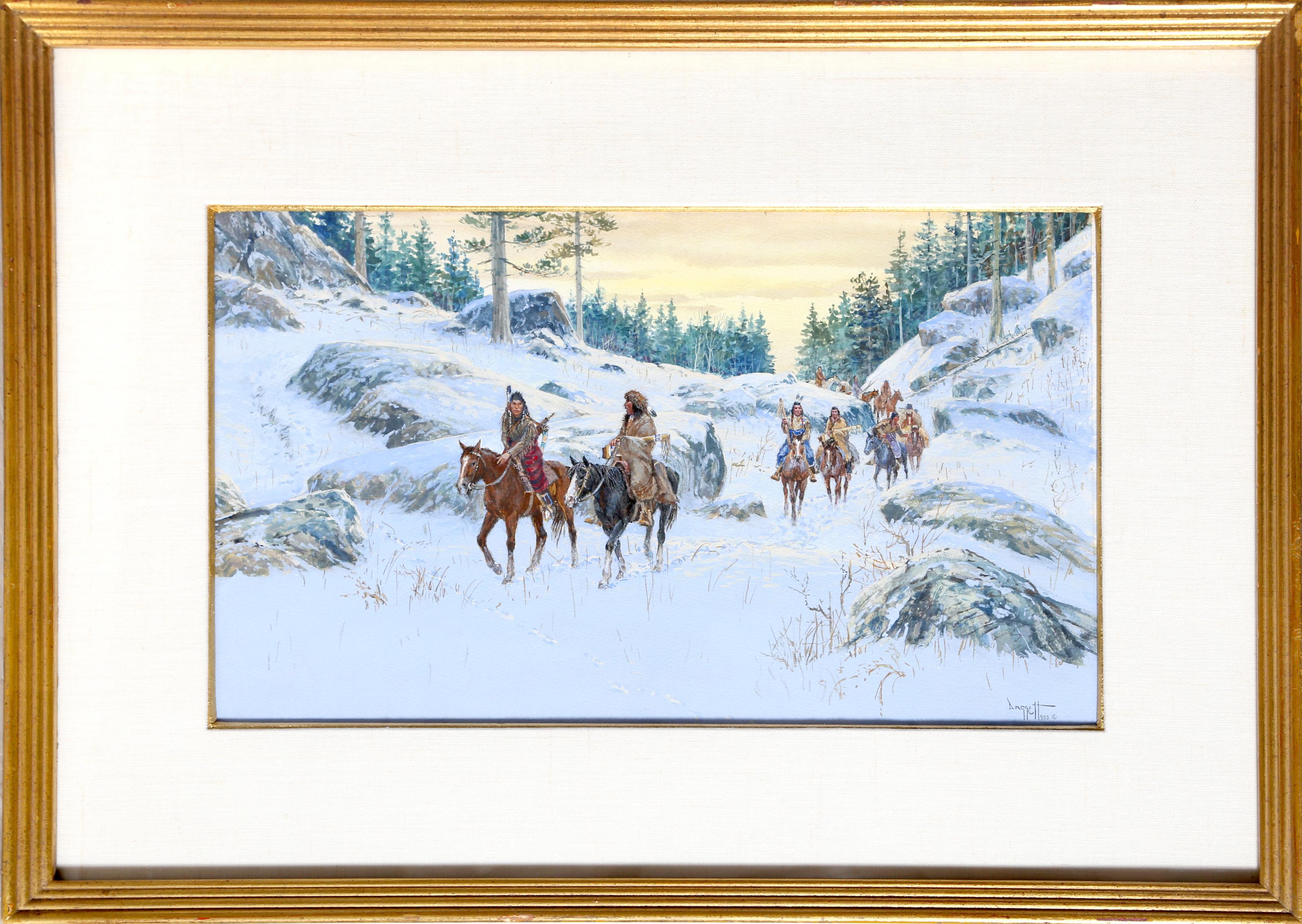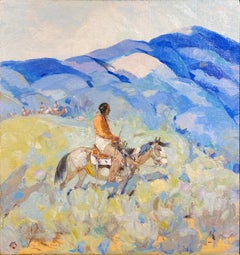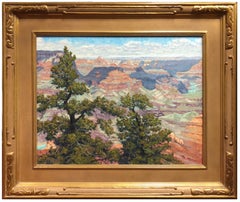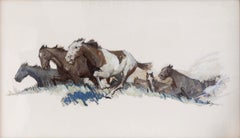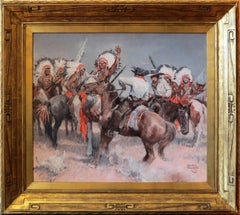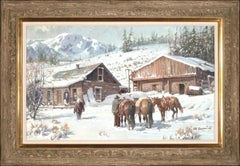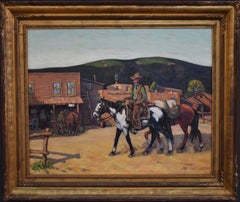Items Similar to Old High Country Woman
Want more images or videos?
Request additional images or videos from the seller
1 of 6
Roy AndersenOld High Country Woman
Price Upon Request
Price Upon Request
Price Upon Request
Price Upon Request
Price Upon Request
Price Upon Request
Price Upon Request
Price Upon Request
Price Upon Request
Price Upon Request
About the Item
Roy Andersen (b. 1930)
"Old High Country Woman"
Oil on Canvas
12 x 16 inches
21.5 x 25 inches framed
Known as a western painter, Roy Andersen did paintings of Crow, Cheyenne, and Apache Indians. He began his career living in Chicago and New York and working as an illustrator. He did numerous covers for Time Magazine including portraits of Albert Einstein and Prince Fahd. He also did illustrations for National Geographic magazine, and did a stamp series on Dogs and American Horses, and in 1984 and 1985, won Stamp of the Year Award. As a muralist, he has filled commissions for the National Park Service, the Royal Saudi Naval Headquarters, and the E.E. Fogelson Vistor Center at Pecos National Monument in New Mexico.
To pursue his talent for painting, Roy Anderson went West, living in Arizona and settling in Cave Creek. In 1990, he was voted official artist for Scottsdale's Parada del Sol, the "world's largest" horse-drawn parade commemorating the Old West.
Andersen grew up on an apple farm in New Hampshire and learned about Indian customs from his many hours spent at the Chicago Museum of Natural History. He is meticulous about being historically accurate in his paintings. Of him it was written: "There are no 'happy accidents' in an Andersen painting. He has a knowledge of his subject that is attained only through extensive research. You will not find an Apache medicine bag around a Sioux warrior's neck nor a Cheyenne carrying a rifle that is a bit too 'modern'. What you will see is accuracy, an almost uncanny sense of composition and color harmony and a strength of drawing that is remarkable. " (Dickerson)
His training is from the Chicago Academy of Fine Art and the Art Center School of Los Angeles.
Influenced by a cowboy uncle from Nebraska, he often painted cowboy scenes that his art teachers said were passe. For thirty years, he was an illustrator for National Geographic, Time magazine and Sports Illustrated and lived in New York and Chicago.
And then he "went West looking for peace and a place where he could be his own man in both his life and his art" (Prix de West, 14). He lived in Arizona and Texas. In 1989, he was voted into membership into the Cowboy Artists of America*, a group from whom he has received recognition at the annual exhibitions: Oil Painting Award, Silver, 1999 and Drawing and Other Media, Silver, 2000.
Sources:
Prix de West 2003 catalogue
Bill Dickerson, Roy Andersen, 1998 Exhibition Catalog of O'Brien's Emporium, Scottsdale, Arizona
Southwest Art magazine
Artist Files of Phoenix Art Museum Library
- Creator:Roy Andersen (1930)
- Dimensions:Height: 21.5 in (54.61 cm)Width: 25 in (63.5 cm)Depth: 1 in (2.54 cm)
- Medium:
- Movement & Style:
- Period:
- Condition:
- Gallery Location:Missouri, MO
- Reference Number:1stDibs: LU74733650271
About the Seller
5.0
Vetted Professional Seller
Every seller passes strict standards for authenticity and reliability
Established in 1970
1stDibs seller since 2017
155 sales on 1stDibs
Typical response time: Several days
- ShippingRetrieving quote...Shipping from: Missouri, MO
- Return Policy
Authenticity Guarantee
In the unlikely event there’s an issue with an item’s authenticity, contact us within 1 year for a full refund. DetailsMoney-Back Guarantee
If your item is not as described, is damaged in transit, or does not arrive, contact us within 7 days for a full refund. Details24-Hour Cancellation
You have a 24-hour grace period in which to reconsider your purchase, with no questions asked.Vetted Professional Sellers
Our world-class sellers must adhere to strict standards for service and quality, maintaining the integrity of our listings.Price-Match Guarantee
If you find that a seller listed the same item for a lower price elsewhere, we’ll match it.Trusted Global Delivery
Our best-in-class carrier network provides specialized shipping options worldwide, including custom delivery.More From This Seller
View AllThe Deer Hunters
Located in Missouri, MO
Laverne Nelson Black (American, 1887-1938)
"The Deer Hunters"
Signed Lower Left
Canvas: 24 x 22 inches
Framed: 30.5 x 28.5 inches
Born in Viola,...
Category
Early 20th Century American Impressionist Landscape Paintings
Materials
Canvas, Oil
Price Upon Request
Heading Up Trail
By William Henry Dethlef Koerner
Located in Missouri, MO
Heading Up Trail
William Henry Dethlef Koerner (German, American, 1878-1938)
Oil on Canvas Board
Signed Lower Left
26 x 30 inches
35.25 x 30.75 inches with frame
William Henry Dethl...
Category
Early 20th Century Other Art Style Figurative Paintings
Materials
Canvas, Board, Oil
The Grand Canyon
By Billyo O'Donnell
Located in Missouri, MO
Billyo O'Donnell (American, 20th C.)
"The Grand Canyon"
Oil on Panel
22 x 29 inches
32 x 38 inches framed
“For more than two decades I’ve been intrigued by the way a painting’s surf...
Category
21st Century and Contemporary American Impressionist Landscape Paintings
Materials
Oil, Panel
Price Upon Request
The Painted Stallion
By William Henry Dethlef Koerner
Located in Missouri, MO
The Painted Stallion
William Henry Dethlef Koerner (German, American, 1878-1938)
Oil on Panel
Signed Lower Right
Titled Verso
21.5 x 37 inches
26.5 x 42.5 inches with frame
Written ...
Category
Early 20th Century American Modern Landscape Paintings
Materials
Oil, Panel
Homestead
By Joan Parker
Located in Missouri, MO
Joan Parker (20th C.)
"Homestead"
Oil on Canvas
11 x 14 inches
13 x 16 framed
Joan Parker, is a Plein Air landscape painter and a native of California. Her artistic abilities were...
Category
21st Century and Contemporary American Impressionist Landscape Paintings
Materials
Canvas, Oil
$2,300
Winter's Blanket
By David Halbach
Located in Missouri, MO
David Halbach
"Winter's Blanket" 1992
Watercolor on Paper
Signed and Dated Lower Left
Image Size: 9 x 11 inches
Framed Size: 14.5 x 16.5 inches
A member of the Cowboy Artists of America since 1985, he has lived in Arizona beginning 1975 and later in the Sierras of California. In 1975, he also won the prestigious Silver Medal at the National Cowboy Hall of Fame show for his watercolor "Story Teller." In 1996 he completed a project for "National Geographic."
He attended the Chouinard Art Institute in Los Angeles, and his teachers were the acclaimed Millard Sheets and Rex Brandt...
Category
1990s American Realist Landscape Drawings and Watercolors
Materials
Watercolor
Price Upon Request
You May Also Like
"Chisholm Trail"
By Charles Hargens
Located in Lambertville, NJ
Jim’s of Lambertville is proud to offer this artwork by:
Charles Hargens (1893 - 1997)
Carversville, Bucks County, Pennsylvania artist and illustrator Charles was born in Hot Springs, South Dakota. As a young boy he loved to draw cowboys, Indians and ranch buildings. By age ten, he was “a commercial success” selling drawings of neighbors’ barns and houses for $25. When he grew older, his parents consented to enroll him at the Pennsylvania Academy (1913-20) where he studied with Daniel Garber, Hugh Breckenridge, Henry McCarter, and William Merritt Chase. At Garber’s invitation, Hargens occasionally came to visit his Lumberville studio to paint with him. A lifelong friendship resulted. In 1915, the Pennsylvania Academy awarded Hargens its Cresson Traveling Scholarship and he went to Paris to study at the Academie Julian and the Academie Colarossi.
Hargens was a fellow of the Pennsylvania Academy and a member of the Society of Illustrators, the National Cowboy Hall of Fame and the Philadelphia Sketch Club. He exhibited at the Art Institute of Chicago (1923 awards) and at the Pennsylvania Academy of Fine Arts (1915 prize, 1917 prize, 1918 award). By the early 1920s, he began to produce illustrations for book jackets, books, magazines and advertisements. His career took off and soon his illustrations of cowboys, Indians, Western life, Revolutionary War action and boy scout themes appeared in, or adorned the covers of The Saturday Evening Post, Collier’s, Liberty, McCall’s, Boy’s Life and Gentlemen’s Quarterly. His work also appeared on billboards and advertisements for Stetson hats and Coca-cola. It was conditioned by Hargens that all of his original art was returned to him after being published. His entire body work remained in his studio until his death in 1997; this is largely the reason his paintings have not yet commanded the high prices of his contemporary Saturday Evening Post illustrators (i.e. Rockwell, Leyendecker and N.C. Wyeth).
At first he and his wife worked from their studio in Philadelphia. In 1940, they purchased a property at the intersection of Aquetong and Sawmill roads in Carversville. They commuted to Philadelphia regularly and stayed in South Dakota every summer. Eventually, he set up a studio next to his Carversville home. After moving to Carversville, Hargens began a lifelong friendship with George Sotter. Hargens’ Carversville home was the subject of many of George Sotter’s paintings long before and during the time Hargens lived there. Hargens also studied with Henry Rand...
Category
1930s American Impressionist Landscape Paintings
Materials
Canvas, Oil
Approach of a Rider, Western Oil Painting by Noel Daggett
By Noel Daggett
Located in Long Island City, NY
Approach of a Rider
Noel Daggett, American (1925–2005)
Date: 1980
Oil on Canvas, signed
Size: 30 x 36 in. (76.2 x 91.44 cm)
Frame Size: 35 x 41 inches
Category
1980s American Realist Landscape Paintings
Materials
Oil
"TRAIL TO EAGLE NEST" WESTERN SNOW COWBOY ARTISTS OF AMERICA NICE! FRAME 32 X 46
By Melvin Warren
Located in San Antonio, TX
Melvin Warren
(1920 - 1995)
Texas Artist
Image Size: 22 x 36
Frame Size: 32 x 46
Medium: Oil
Dated 1987
"Trail To Eagle Nest" Western Snow Scene
Biography
Melvin Warren (1920 - 1995)
Melvin Charles Warren (March 19, 1920-August 4, 1995)
For western art to achieve the distinction of fine art, it must first satisfy an artistic criteria and only then deal with the particularity of western subject matter. Melvin Warren understands this concept. His work is an accomplished artistic statement that also presents images which are faithful to western reality.
Warren was born in California in 1920 and lived in Arizona and New Mexico before coming to Texas at the age of fourteen. He has seen the beauty and felt the lure of the Southwest and it stimulated his boyhood desire to be an artist. After service in World War II, Warren entered Texas Christian University and received a degree in fine arts. During the day, he worked in the best tradition of commercial art work, and in the evenings he painted out the western fantasies that crowded his mind.
These paintings and the process of creating them encouraged Warren to seek a gallery outlet. The subtle sensitivity to his subject matter and an obvious control of the technical elements of painting made his work readily acceptable to a broad range of collectors. He became a special favorite of Lyndon Johnson who ultimately acquired many Warren oils.
Melvin C. Warren is buried at Clifton Memorial Park, Clifton, Bosque County, Texas.
The artist was born in Los Angeles, California in 1920. He died in Clifton, Texas in 1995. The artist lived as a child on ranches throughout California, Arizona, New Mexico and Texas. He served in the Air Force during WWII.
Warren earned a degree in Fine Art from Texas Christian University in 1952 and also studied under Samuel Ziegler. His palette emphasizes earth tones -browns, reds, yellows. His subject matter emphasizes the history of the West - cattle trails and frontier forts.
He was a member of the Cowboy Artists...
Category
1990s Impressionist Landscape Paintings
Materials
Oil
"Down By The Rio Grande" Texas Cowboy Western Dallas Artist Fred Darge 1900-1978
Located in San Antonio, TX
Fred Darge (1900-1978) Dallas Image Size: 24 x 30 Frame Size: 32 x 38 Medium: Oil, "Down By The Rio Grande"
Biography
Fred Darge (1900-1978)
Friedrich Ernst Darge Born: March 1 1900 Rendsburg, Germany Died: April 10 1978 Dallas, Texas Entered the U.S. ; Jan. 14 1923 at Port Arthur, Texas. By 1924 he was in Chicago painting under the W.P.A. Artists policy and attending the Art Institute of Chicago from where he graduated. While in Chicago he painted and made model sail boats...
Category
1940s Impressionist Landscape Paintings
Materials
Oil
When Mountains Turn Cold, American Western Art Gouache Painting by Noel Daggett
By Noel Daggett
Located in Long Island City, NY
Noel Daggett, American (1925 - 2005) - When Mountains Turn Cold (Crow Indians), Year: 1990, Medium: Gouache on Board, signed and dated l.r., Size: 10 in. x 17 in. (25.4 cm x 43.18...
Category
1990s American Realist Animal Drawings and Watercolors
Materials
Gouache
Vladan Stiha Native Americans in New Mexico
Located in San Francisco, CA
Vladan Stiha: 1908-1992. Well listed New Mexico artist with auction records over $12,000. He was born in Yugoslavia and tried to emigrate to the U.S. duri...
Category
1980s American Impressionist Figurative Paintings
Materials
Oil
